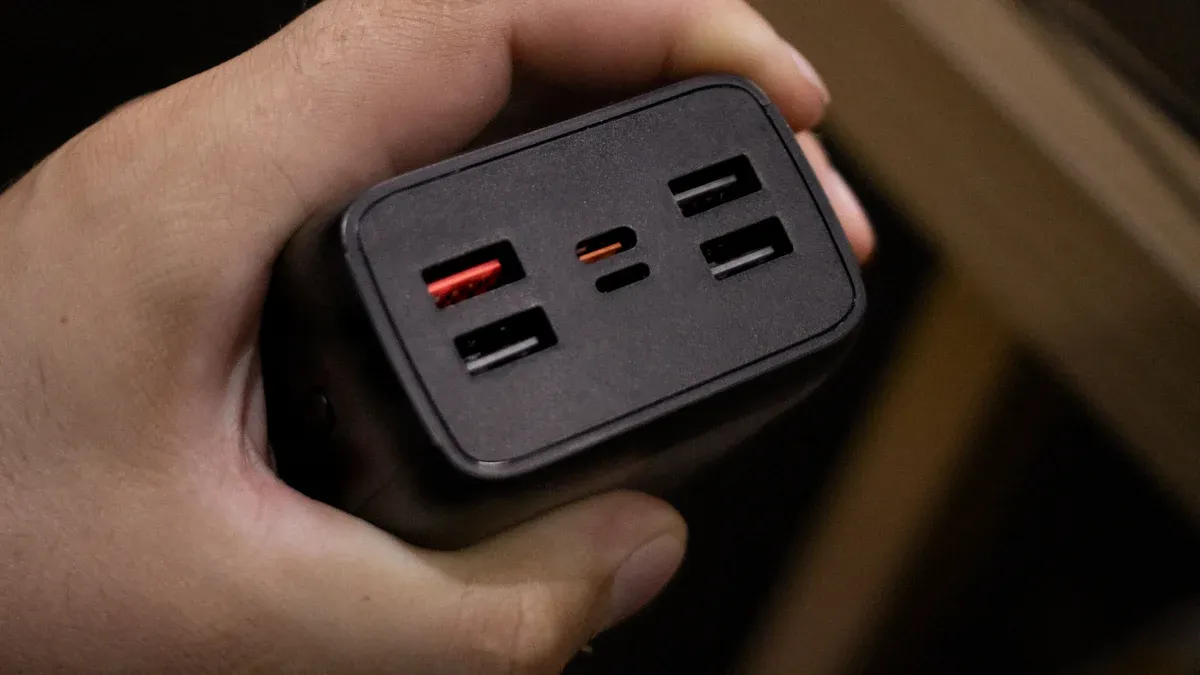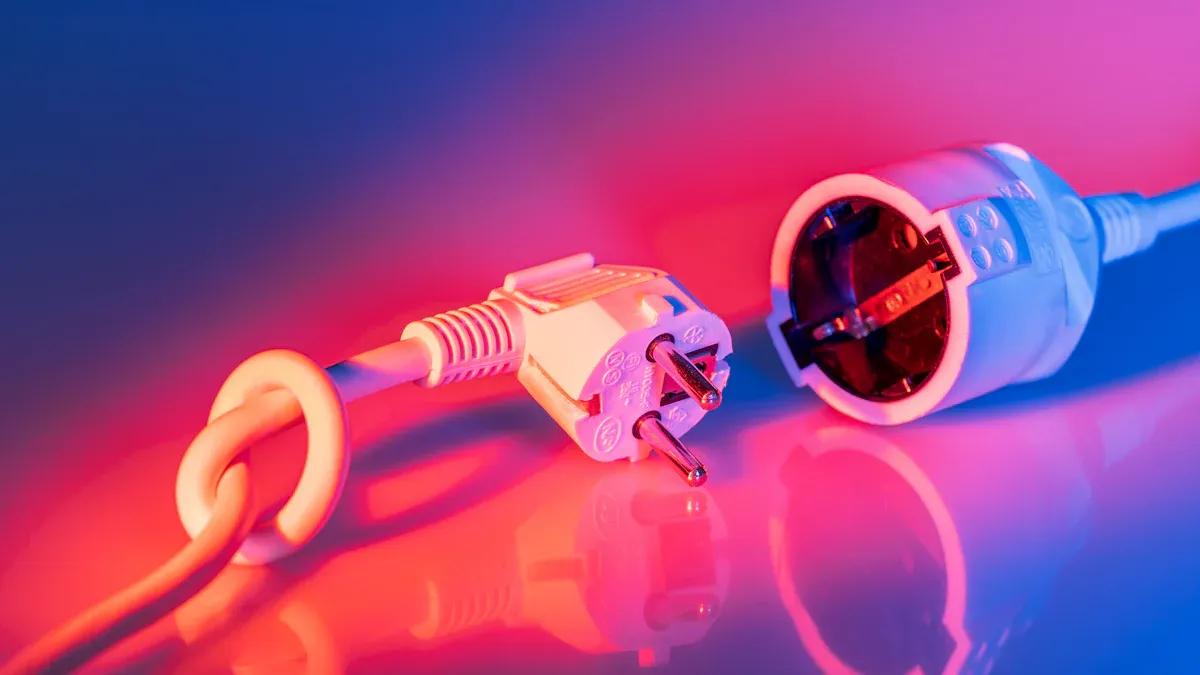Understanding the Value of Power Conditioners and Surge Protectors
Protecting your electronics means understanding the differences between a power conditioner vs surge protector. A surge protector keeps your devices safe from sudden voltage jumps, while a power conditioner goes further by controlling voltage and reducing electrical noise. Picking the right one between a power conditioner vs surge protector saves money and helps your devices last longer.
Electronics now have advanced processors and mobile features. Devices like laptops and tablets run heavy programs and make tasks easier. Their portability helps you work better, but their delicate parts need good power protection. Choosing the right tool, whether it's a power conditioner or a surge protector, keeps your electronics safe and working well.
Key Takeaways
Surge protectors stop sudden power jumps and keep devices safe.
Power conditioners give steady power and cut electrical noise for gadgets.
Use surge protectors for simple items like TVs and phone chargers.
Pick power conditioners for expensive devices needing smooth, steady power.
Check the joule rating on surge protectors; higher means better safety.
Think about your area; frequent outages need surge protectors.
Unstable voltage areas work better with power conditioners.
Read reviews to find the best surge protector or power conditioner.
Using both together gives the best protection for your electronics.
Surge Protectors: Features and Benefits

What Are Surge Protectors?
Definition and functionality
A surge protector keeps your electronics safe from sudden power jumps. These jumps, called surges, happen when electricity flows too strongly. Surge protectors stop extra power from reaching your devices. They use parts like MOVs (metal oxide varistors) to absorb and redirect the extra energy. MOVs change how they work when the power gets too high.
Common applications
Surge protectors are useful at home or work. They protect things like TVs, computers, and gaming systems. For special equipment, like medical tools or servers, surge protectors are very important. They help prevent damage from unexpected power surges.
Key Features of Surge Protectors
Voltage spike protection
Surge protectors stop sudden power increases from harming your devices. A power surge can break electronics, like too much water can burst a pipe. Surge protectors absorb and redirect the extra energy to keep devices safe.
Joule rating explained
The joule rating shows how much energy a surge protector can handle. Higher joule ratings mean better protection. For example, a 1,000-joule protector is stronger than a 500-joule one. This helps you pick the right protector for your needs.
Studies show surge protectors work well against strong power surges. They act fast, absorb energy, and keep signals clear. Tools like MOVs and gas discharge tubes give different types of protection.
Benefits of Surge Protectors
Affordable and accessible protection
Surge protectors are a cheap way to protect electronics. They come in many prices and are easy to find. Type 3 surge protectors work with Type 1 and Type 2 devices for full protection.
Ideal for basic electronics
Surge protectors are great for simple devices like lamps and chargers. They help reduce problems with equipment. For example, FedEx Express fixed power issues, and T & T Shell Gas saved $20,000 over ten years by using surge protectors.
Standard/Document | Description |
|---|---|
CEI 64-8 | Requires surge protectors in certain places to keep people and property safe. |
CEI 81-10 | Explains how to size lightning protection systems. |
Type 1 SPDs | Installed in panels to stop lightning-related power surges. |
The need for surge protectors is growing as electronics become more advanced. Using one helps keep your devices safe and working longer.
Power Conditioners: Features and Benefits

What Are Power Conditioners?
Definition and functionality
A power conditioner improves the electricity your devices receive. It keeps voltage steady, removes electrical noise, and handles power changes. Surge protectors block sudden power spikes, but power conditioners give clean and stable electricity. They smooth out the flow of power and keep voltage levels consistent. This is important for delicate electronics that need reliable power to work well.
Common applications
Power conditioners are used where good power quality matters most. They are found in studios, hospitals, and data centers. For example, audio power conditioners make sound clearer by removing noise. Rackmount power conditioners are used in server rooms and AV systems to power many devices. They also protect medical tools, helping them work correctly during procedures.
Key Features of Power Conditioners
Voltage regulation and noise filtering
Power conditioners keep voltage levels stable to protect electronics. They stop high or low voltage from damaging devices. Voltage regulators adjust power to match what your equipment needs. Filters remove electrical noise, improving sound and video quality. This makes audio clearer and video sharper for better performance.
Protection against power fluctuations
Power conditioners protect devices from sudden power changes. They absorb spikes and smooth out uneven electricity. For example, the aR2p power conditioner reduces noise, improving audio and video quality. These features make them important for expensive equipment needing clean power.
Benefits of Power Conditioners
Enhanced performance for sensitive electronics
Power conditioners help delicate devices work better. They remove electrical noise that can cause problems. Audio systems sound better, and video equipment shows sharper images. Studies show Unified Power Quality Conditioners (UPQCs) improve power in places like railways and airports.
Long-term protection for high-value equipment
Power conditioners help expensive electronics last longer. They keep voltage steady and remove noise, reducing damage over time. For example, Cairo Airport used transformerless UPQCs to fix voltage issues and protect equipment. Whether for medical tools or AV systems, power conditioners offer lasting benefits beyond better performance.
Power Conditioner vs Surge Protector: Key Comparisons
Functional Differences
Surge protection vs power regulation
Surge protectors stop power spikes from harming electronics. They absorb extra energy before it damages devices. Power conditioners make electricity steady and clean. They keep voltage stable and remove electrical noise for better power quality.
Older Furman power conditioners use MOVs to block surges. MOVs absorb energy but wear out after use. Newer Furman power regulators use series mode technology. This method protects without wearing out and keeps power steady at 120 volts and 60Hz.
Feature | Older Furman Power Conditioners | Newer Furman Power Regulators |
|---|---|---|
Surge Protection Type | Metal Oxide Varistors (one-shot) | Series Mode (non-sacrificial) |
Voltage Regulation | Not specified | Maintains 120VAC output |
Frequency Regulation | Not specified | Maintains 60Hz output |
Types of electrical issues addressed
Surge protectors handle sudden power surges from lightning or bad wiring. These surges can break electronics quickly. Power conditioners fix more problems like voltage changes, noise, and distortion. They work well in places with old wiring or frequent outages.
Cost Differences
Price range comparison
Surge protectors cost less than power conditioners. Whole-house surge protectors cost $100–$200. Power strip surge protectors cost $20–$70. Power conditioners start at $200 and can cost over $1,000 for advanced features.
Long-term cost-effectiveness
Choosing the right device saves money over time. Without surge protection, damages can cost thousands. A surge protection system costs less than $1,000. Surge protectors need replacing every few years, adding to costs. Power conditioners last longer and protect expensive devices better, making them worth the price.
Ideal Use Cases
When to choose a surge protector
Surge protectors are good for basic electronics like TVs and computers. They are important for outdoor devices like security cameras. For example, Frenchman’s Creek used DITEK surge protectors to protect cameras from lightning. This kept the cameras working with little downtime.
When to choose a power conditioner
Power conditioners are great for setups needing steady power. Musicians use them to keep audio equipment working well. They also help in places with bad power by removing interference. Studios and hospitals use power conditioners for clean electricity and better performance.
Choosing Between Power Conditioners and Surge Protectors
Assessing Your Needs
Identifying electronics to protect
First, figure out which devices need protection. Computers, TVs, and gaming consoles often need surge protectors. Sensitive devices like medical tools, audio systems, or servers need power conditioners. These devices work best with steady voltage and clean electricity.
Think about what your electronics require to stay safe. Manufacturers test their products to meet safety rules. For example:
Follow rules for insulation and resistance levels.
Keeping records like wiring plans and safety reports helps you choose wisely. This keeps your devices safe and working well over time.
Evaluating environmental risks
Your location affects the type of protection you need. Areas with storms or frequent outages need surge protectors. These are affordable and protect basic devices. If your area has unstable voltage or brownouts, power conditioners are better. They stabilize voltage and reduce electrical noise.
Type 1 and Type 2 SPDs handle strong currents and work in tough conditions. The table below shows current levels and limits for SPD types:
Type SPD | Current Test Level | Limiting Current |
|---|---|---|
Type 1, 1CA, 2, 2CA | Min. 5 kA, Max. 200 kA | 10, 5, 25 & 0.5 A |
Type 3, 3CA | N/A | 5, 2.5, 0.5, 0.125, & 0.06 A |
Type 4 CA | N/A | 10, 5, 2.5, 0.5, 0.125, & 0.06 A |
By checking these risks, you can pick the right device for better safety and longer-lasting electronics.
Budget Considerations
Balancing upfront costs and savings
Think about the cost now versus savings later. Surge protectors cost less upfront and work well for basic devices. But they may need replacing often, which adds to costs.
Power conditioners cost more at first but save money over time. They protect expensive devices and help them last longer. Studies show homes can save up to $2,500 yearly with smart tech. Lower energy bills often cover the cost of these devices.
Key Findings | Description |
|---|---|
Upfront Costs | Government loans help pay for home electrification. |
Long-term Savings | Energy savings can exceed costs, creating new jobs. |
Prioritizing cost-effectiveness
Choose based on what you need most. If you only need surge protection, a surge protector is cheaper. If you need steady power or backup for sensitive devices, a power conditioner or UPS is better.
A UPS gives both power conditioning and backup power. It keeps devices running during outages, making it a smart choice for places needing constant electricity.
Practical Tips for Selection
Researching product reviews
Check reviews before buying. Look for details on surge protection, voltage control, and durability. See how well the device handles outages or provides backup power.
Some UPS models offer advanced features for clean electricity. Reviews can help you find the right product for your needs.
Consulting professionals for complex setups
For tricky setups like studios or hospitals, ask a professional. They can check your power needs and suggest the best solution. This could be a power conditioner, UPS, or another device.
Professionals ensure proper installation and safety compliance. Keeping wiring plans and safety reports makes maintenance easier. This protects your devices and improves their performance over time.
Deciding on a power conditioner or surge protector depends on your devices and location. Surge protectors guard against sudden power surges, while power conditioners deliver stable voltage and clean power for delicate electronics.
Tip: Use a surge protector for everyday gadgets like TVs or chargers. Choose a power conditioner for expensive devices needing steady electricity.
Picking the right option saves money and keeps your devices working longer. Protecting electronics helps them run smoothly and avoids expensive fixes.
FAQ
What is the main difference between a surge protector and a power conditioner?
A surge protector stops sudden power spikes from harming devices. A power conditioner keeps voltage steady and removes electrical noise. Use surge protectors for simple gadgets and power conditioners for delicate equipment like studio tools.
Can I use a surge protector for my studio equipment?
Surge protectors give basic safety but may not suit studio needs. Studios need clean, steady power, which power conditioners provide. They improve performance and protect costly equipment.
How do I know if I need a power conditioner?
If your devices face power changes or noise problems, get a power conditioner. Studios, hospitals, and data centers often use them for reliable power.
Are power conditioners worth the higher cost?
Power conditioners cost more but save money in the long run. They protect expensive devices, boost performance, and make equipment last longer. Studios benefit from their clean power supply.
Can I use both a surge protector and a power conditioner together?
Yes, using both gives better protection. Surge protectors stop power spikes, and power conditioners keep voltage steady and remove noise. Studios often combine them for maximum safety.
What type of surge protector is best for outdoor equipment?
Pick a Type 1 or Type 2 surge protector for outdoor gear. These handle strong power surges and protect items like security cameras. Studios with outdoor setups also use these protectors.
How do power conditioners improve audio and video quality?
Power conditioners remove noise and keep voltage stable. This reduces distortion, making sound clearer and images sharper. Studios depend on these features for top-quality results.
Are there alternatives to power conditioners for studios?
Uninterruptible Power Supplies (UPS) offer similar benefits. They give backup power during outages and stabilize voltage. Studios often use UPS systems with power conditioners for full protection.
See Also
A Comprehensive Guide to Various Inverter Chip Types
A Beginner's Guide to Selecting DC-DC Converters
Comparing Inverters and Transformers: Key Functional Differences
